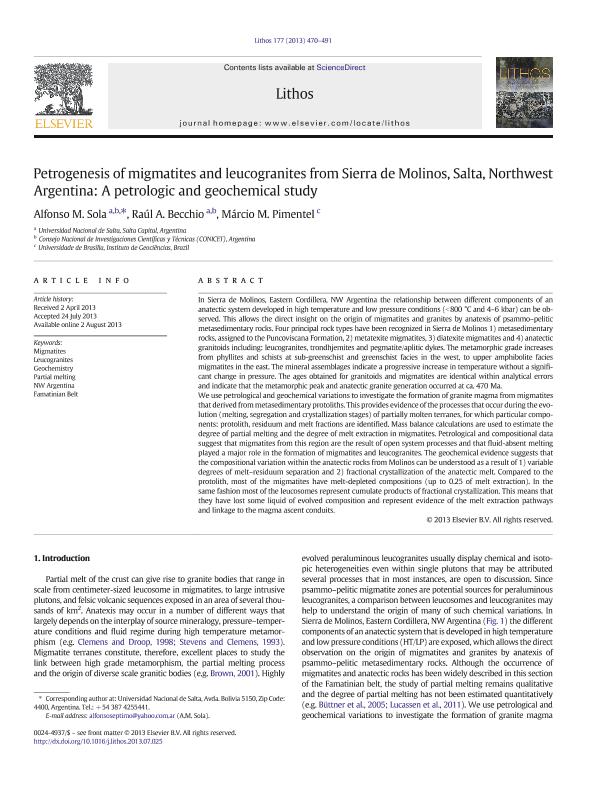Artículo
Petrogenesis of migmatites and leucogranites from Sierra de Molinos, Salta, Northwest Argentina: A petrologic and geochemical study
Fecha de publicación:
09/2013
Editorial:
Elsevier Science Bv
Revista:
Lithos
ISSN:
0024-4937
Idioma:
Inglés
Tipo de recurso:
Artículo publicado
Clasificación temática:
Resumen
In Sierra de Molinos, Eastern Cordillera, NW Argentina the relationship between different components of an anatectic system developed in high temperature and low pressure conditions (800 °C and 4_6 kbar) can be observed. This allows the direct insight on the origin of migmatites and granites by anatexis of psammo?pelitic metasedimentary rocks. Four principal rock types have been recognized in Sierra de Molinos 1) metasedimentary rocks, assigned to the Puncoviscana Formation, 2) metatexite migmatites, 3) diatexite migmatites and 4) anatectic granitoids including: leucogranites, trondhjemites and pegmatite/aplitic dykes. The metamorphic grade increases from phyllites and schists at sub-greenschist and greenschist facies in the west, to upper amphibolite facies migmatites in the east. The mineral assemblages indicate a progressive increase in temperature without a significant change in pressure. The ages obtained for granitoids and migmatites are identical within analytical errors and indicate that the metamorphic peak and anatectic granite generation occurred at ca. 470 Ma. We use petrological and geochemical variations to investigate the formation of granite magma from migmatites that derived from metasedimentary protoliths. This provides evidence of the processes that occur during the evolution (melting, segregation and crystallization stages) of partially molten terranes, for which particular components: protolith, residuum and melt fractions are identified. Mass balance calculations are used to estimate the degree of partial melting and the degree of melt extraction in migmatites. Petrological and compositional data suggest that migmatites from this region are the result of open system processes and that fluid-absent melting played a major role in the formation of migmatites and leucogranites. The geochemical evidence suggests that the compositional variation within the anatectic rocks from Molinos can be understood as a result of 1) variable degrees of melt?residuum separation and 2) fractional crystallization of the anatectic melt. Compared to the protolith, most of the migmatites have melt-depleted compositions (up to 0.25 of melt extraction). In the same fashion most of the leucosomes represent cumulate products of fractional crystallization. This means that they have lost some liquid of evolved composition and represent evidence of the melt extraction pathways and linkage to the magma ascent conduits.
Archivos asociados
Licencia
Identificadores
Colecciones
Articulos(CCT - SALTA-JUJUY)
Articulos de CTRO.CIENTIFICO TECNOL.CONICET - SALTA-JUJUY
Articulos de CTRO.CIENTIFICO TECNOL.CONICET - SALTA-JUJUY
Articulos(INENCO)
Articulos de INST.DE INVEST.EN ENERGIA NO CONVENCIONAL
Articulos de INST.DE INVEST.EN ENERGIA NO CONVENCIONAL
Citación
Sola, Alfonso Manuel; Becchio, Raul Alberto; Pimentel, Márcio M.; Petrogenesis of migmatites and leucogranites from Sierra de Molinos, Salta, Northwest Argentina: A petrologic and geochemical study; Elsevier Science Bv; Lithos; 177; 9-2013; 470-491
Compartir
Altmétricas




